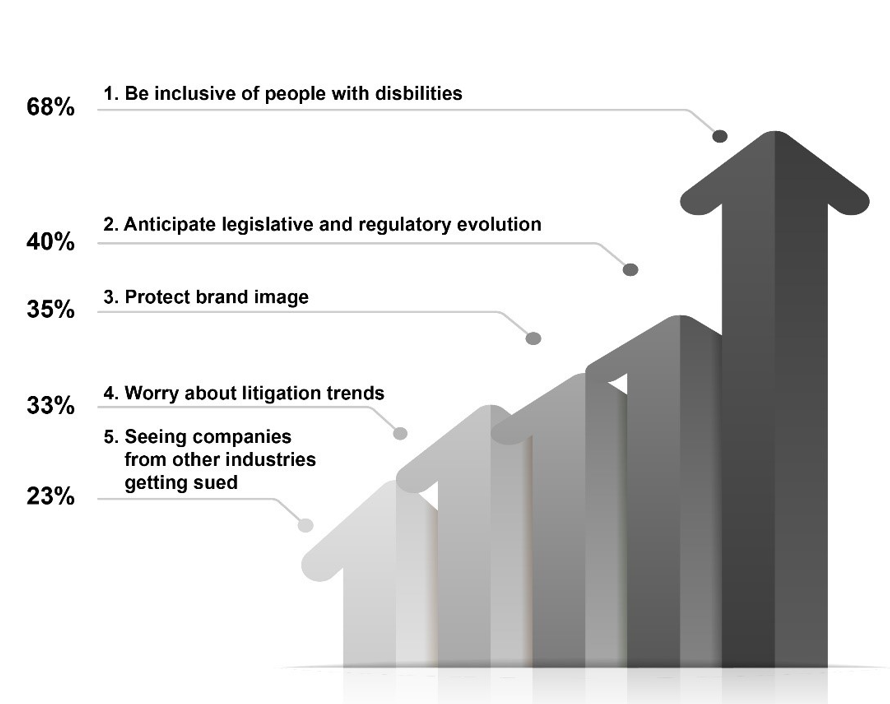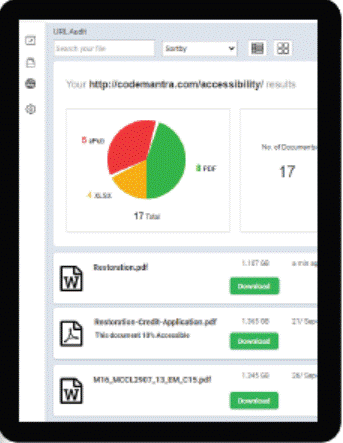Introduction
Digital accessibility is becoming increasingly important in state and local government agencies as they strive to create an inclusive environment for all citizens.
Accessible digital services provide essential services such as applications for permits, licenses, welfare, and more. By making these services available in a digital format, government agencies are able to better serve their constituents and provide equitable access, and reduce costs.
Importance of digital accessibility in state/local government agencies
The Americans with Disabilities Act (ADA) is the law that sets a standard for digital accessibility in state and local government agencies.
This law requires that all government agencies make their websites and digital services accessible to people with disabilities.
This includes making the content available in different formats, such as text, audio, and video, to ensure that everyone can access the services.
Additionally, the ADA requires that the websites are easy to use and have navigable menus, clear navigation labels, and sufficient contrast between text and background.

Source: Level Access, 2020 State of Digital Accessibility Report
State and local governments can also benefit from providing digital accessibility to their websites and services.
By making the services accessible, government agencies can improve customer satisfaction and enable more people to access their services.
Additionally, accessible services can reduce the need for manual labor and assistive technology, which can help reduce costs.
Digital accessibility can also help government agencies better serve their constituents, as it allows more people to access services without the need for physical assistance.
Legal requirements for accessibility
State and local governments are obligated to provide accessibility to their services to individuals with disabilities. This requirement is mandated by the Americans with Disabilities Act (ADA), which is a civil rights law that prohibits discrimination against people with disabilities.
Under the ADA, state and local governments must provide reasonable accommodations to ensure that individuals with disabilities can access public services, programs, and activities.
The Americans with Disabilities Act (ADA)
The Americans with Disabilities Act (ADA) is a comprehensive civil rights law enacted by the U.S. Congress in 1990. It applies to all entities that are open to the public, including government agencies, private businesses, and non-profit organizations.
It is designed to protect individuals with disabilities from discrimination in all aspects of daily life, including employment, public accommodations, transportation, and telecommunications.
The ADA outlines specific requirements for physical accessibility, such as providing accessible parking and entrances, installing accessible doors, and providing accessible surfaces and ramps.
In addition, state and local governments must ensure digital accessibility by providing access to websites and online services. This may include providing accessible content via web browsers, installing assistive technology such as screen readers, providing keyboard navigation, and more.
These legal requirements are in place to ensure that individuals with disabilities can access state and local government services in the same way and with the same ease as individuals without disabilities.
Section 508 of the Rehabilitation Act
Section 508 of the Rehabilitation Act of 1973 requires federal agencies to make their electronic and information technology (EIT) accessible to people with disabilities. This includes websites, software, hardware, and other electronic media.
The act was amended in 1998 to include electronic and information technology developed, procured, maintained, or used by the federal government. The act specifies that EIT should be as accessible as is possible, including providing visual, auditory, and cognitive access for people with disabilities.
To comply with Section 508, EIT must meet certain standards for usability, including providing options for users to adjust font sizes and colors, having a system for navigating the website, and making sure that the content is formatted in an easily readable manner.
Additionally, audio, video, and multimedia content must include captions, audio descriptions, and other accessible features.
Government agencies must also provide alternative access for people with disabilities to information that is not provided in an accessible format. This includes providing alternative methods of accessing the same content, such as providing printed transcripts, Braille documents, or audio recordings.
Consequences of non-compliance
Non-compliance with Section 508 of the Rehabilitation Act can have serious consequences for state and local governments.
Under the law, federal agencies are authorized to withhold funding from states and local governments that fail to provide accessible EIT.
Furthermore, state and local governments that fail to comply with Section 508 may risk being sued for discrimination under the Americans with Disabilities Act (ADA).
The consequences of non-compliance may include:
- Paying a civil penalty
- Setting up an accessibility team, or
- Revising website content and software
The cost of non-compliance can be significant, as it may involve redesigning websites, purchasing new software, or providing additional training for staff.
Additionally, state and local governments may be subject to increased public scrutiny if they fail to meet the requirements of Section 508, which may have a negative effect on their reputation.
Ultimately, it is essential that state and local governments take steps to comply with Section 508 in order to avoid the potential consequences of non-compliance.
Benefits of accessibility for government agencies and citizens with disabilities
Accessibility is becoming increasingly important for government agencies to provide equitable services to citizens with disabilities. With advancements in technology, it is now possible to create digital platforms and physical spaces that are accessible to everyone, regardless of their abilities. There are many benefits of accessibility for both government agencies and citizens with disabilities.
Accessibility helps government agencies:
- Reach a larger audience and provide services to all citizens
- Improve agency reputation
- Saves time and resources by eliminating the need for separate processes for citizens with disabilities
Accessibility also helps to ensure that all citizens have equal access to information and services, which is a key aspect of democratic societies.
By incorporating accessibility into their practices and processes, government agencies can make a positive impact on the lives of citizens with disabilities and promote a more inclusive society.
A. Improved Access to Information and Services for Citizens with Disabilities
Accessibility greatly increases access to information and services provided by the government to federal employees and citizens with disabilities.
By implementing accessibility, government agencies can ensure that individuals with disabilities are able to access information and services on an equal basis with individuals without disabilities.
Accessibility also encourages and facilitates the meaningful participation of individuals with disabilities in the governance and decision-making process.
Furthermore, accessibility removes barriers for citizens with disabilities, allowing them to take advantage of government services without the need for costly accommodations or modifications.
B. Increased Efficiency and Cost Savings
Government agencies that prioritize accessibility can save time, money, and resources by avoiding the costly litigation and remediation associated with non-compliance.
Implementing accessibility also allows government agencies to maximize their resources, as they can reach more citizens with fewer resources.
Additionally, accessibility helps to improve the user experience, which can save time and money by reducing help desk tickets, user frustration, and support costs.
C. Improved public perception and reputation
Accessibility not only improves the lives of citizens with disabilities, but it also has a positive impact on the reputation of government agencies.
By demonstrating their commitment to accessibility and inclusivity, government agencies can improve their public perception and reputation.
This can lead to increased trust and support from citizens with disabilities and the general public. The offshoot is that, it leads to improved outcomes and a more positive perception of government agencies overall.
How codemantra’s accessibilityInsight Helps State/Local Government Agencies Achieve Compliance?
codemantra’s accessibilityInsight is a tool that helps state/local government agencies achieve digital accessibility compliance. It uses advanced AI technology to scan websites and documents, identifying accessibility issues and providing solutions to fix them.
With accessibilityInsight, government agencies can ensure that their digital content is accessible to people with disabilities, in compliance with the Americans with Disabilities Act (ADA) and Section 508 of the Rehabilitation Act.
The tool also provides regular reports on the agency’s compliance status, making it easier to track progress and maintain accessibility standards over time.
By using codemantra’s accessibilityInsight, government agencies can provide equal access to their digital content and services, while also avoiding costly lawsuits and negative publicity associated with non-compliance.
Overview of the accessibilityInsight tool
accessibilityInsight™ product is an AI-powered platform to assess and remediate documents to global accessibility standards.
codemantra’s accessibilityInsight™ is an intelligent document processing platform that embraces machine learning to automate up to 80% of document accessibility production to auto-tag documents, creating structure that facilitates assistive technologies such as JAWS, NVDA, etc.
codemantra’s accessibilityInsight™ platform makes digital assets, including PDF, audio, video (CC), and URL links, accessible for print-disabled citizens by conforming to AA standards of WCAG 2.1.
accessibilityInsight™ consists of a suite of three individual modules that provide for the assessment, remediation, and quality control of accessible output.
Document Transformation through Scalable AI-Driven Modules
accessibilityCheck is an accessibility compliance validator for PDF and MS Office documents. It enables user intuitive reporting across multiple categories.
accessibilityFix performs large-scale automated remediation of documents. It executes artificial intelligence based accessibility prediction in the uploaded PDF document and provides a fully remediated output without any human intervention.
accessibilityReview includes automated prediction and user intuitive interfaces. It provides automatic support for custom alt text for equations.

About accessibilityCheck
accessibilityCheck is a cloud-based multi-document audit and compliance report module that performs a comprehensive audit of digital documents in any format (PDF, Word, Excel, PPT, EPUB formats). The documents are assessed for accessibility compliance against PDF/UA standards and WCAG 2.1 guidelines.

Benefits
- Comprehensive audit and assessment of multiple document formats
- Integration into any business application or platform through a REST API
- Rapid generation of compliance report within minutes
About accessibilityFix
accessibilityFix is an automated PDF accessibility remediation module. It scans individual pages, each individual element, tags appropriately and returns back fully remediated file without human intervention. The output is compliant with federal ADA and Section 508 laws as well as state laws.

Benefits
- Seamless integration into any business application or platform workflow
- Accurate accessibility remediation of PDFs in accordance with PDF/UA standards
- Reduces the time to make PDFs fully accessible
About accessibilityReview
accessibilityReview is a cloud based service that helps perform document validation and PDF remediation to help achieve accessibility compliance.

Benefits
- Comprehensive manual validation across all document types
- Users can generate document accessibility compliance report within minutes
- Users can provide alt text for equations and review auto-generated Math descriptions
How accessibilityInsight identifies and fixes accessibility issues?
The accessibilityInsight™ platform derives structure and intelligence from documents using a two-pronged approach.
- An image processing module generates the visuals and works in tandem with the AI-based core engine. The engine extracts structure from the document using purpose-built machine learning (ML) models.
- The structure that the AI-based engine decodes is then used to transform the document into a format that is compliant with accessibility standards.
Benefits of accessibilityInsight
1. Ensures Data Security and Compliance
codemantra’s accessibilityInsight™ ensures the security and compliance of data for federal, state, and local government agencies. The business emphasizes data security and compliance on both a product and a strategic level.
2. Multiple procurement options
There are several procurement options through multiple vehicles (CMAS, CA-SLP, NASPO) for state and local agencies.
About codemantra
codemantra has engaged with various State Agencies to address their website and document compliance requirements.
The company serves on the W3C’s accessibility advisory body and attends the EU’s Web Accessibility Initiative – contributing to the debate ahead of the 2025 EU Disability Act, as part of the EU’s new 10-year disability inclusion strategy. codemantra is SOC 2 compliant and ISO certified for quality management.
We provide a VPAT (The Voluntary Product Accessibility Template) to help buyers planning to purchase the product.
Every new client codemantra partners with follows an extensive consultancy and discovery process to establish the optimal engagement process, bringing subject expertise and workflow experience together to establish an effective way forward.









